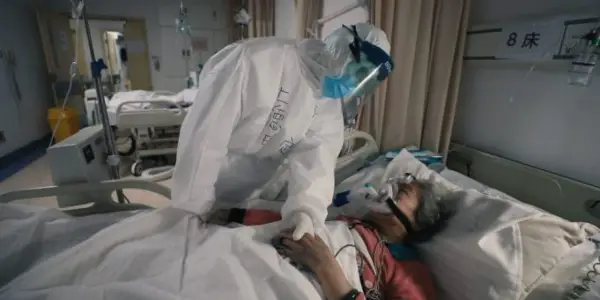76 DAYS: The Faces Of Strength And Hope In Crisis

Stephanie Archer is 39 year old film fanatic living in…
When you first hear of 76 Days and its subject matter, there is an array of emotions that come flooding, with concern and curiosity dueling for the final word. Premiering at the Toronto International Film Festival, the global pandemic this documentary centers around forcing the annual festival to resort to virtual screenings, 76 Days, directors Weixi Chen and Hao Wu, threatens to be a film that is questionably “too soon.” As many of us are still living with the threats of more (on top of those currently imposed) lockdowns, and numbers of positive cases, hospitalizations and deaths continue to climb, 76 Days initially feels as though it could have waited. Thankfully, it did not.
Focusing on the 76 days of lockdown experienced by the citizens of Wuhan, China beginning on January 23, 2020, the documentary follows the front line healthcare workers throughout the pandemic crisis as they treat the overwhelming amount of infections, fight to save the lives of their patients and push their bodies, minds and souls to the limit. 76 Days is not a film that sets out to point a finger or to place blame, but rather captures the beginning of a pandemic that would grip the world. Capturing the chaos, the overwhelming grief and unrelenting hope experienced in Wuhan and the hero’s who selflessly responded.
Rise Up
76 Days is not afraid to show the pain the Covid-19 crisis has placed on the human mind and those who immersed themselves within its unrelenting grasp. Immediately, the documentary opens to healthcare workers in hazmat suits and a woman pleading for the chance to say goodbye as her loved one who has succumbed to the devastation of the virus. While it is an impactful start, immediately laying out the framework of the film, it is the understanding that the woman is a healthcare worker, and the pain she is feeling now is a moment of grief shared by many. While her profession makes her uniquely qualified to respond, she is not immune to the pain and loss of the pandemic. Nor is she given any allowances over others. Like many throughout the city, she does not get the chance to say goodbye, to hug him one more time or to accompany his body to the morgue. Rather, she is asked by her coworkers to be strong, to rest in preparation of her shift later that day. She is asked to rise up. And she is not alone.

The scene is louder than one would think, and thrown into sharp focus moments later as the empty streets of Wuhan are shown, a lonely ambulance’s siren cutting through the silence that has befallen the city. It’s hard as a viewer at this point to grasp the reality of the situation, all too close to fully comprehend, yet still too far grasp. There is a surreal feeling as you watch the ambulance, as though you are watching a fictional creation out of 28 Days or Contagion, a scene you never thought you would see in real life. There are various moments such as this throughout the film, a momentary reprieve from the hospital settings, the sirens a sound many of us have become all to familiar with in our corners of the world, yet still to fresh to completely process art come to life.
While there are these moments outside the hospital, sounds and visuals that may be too familiar and raw for some, it is the moments within the hospital that truly give shape to the roles of healthcare workers during this crisis. They are no longer just doctors and nurses monitoring vitals and monitors, administering treatments and medications. Rather, they have transformed into conduits of care that go beyond medicine. With limited knowledge on the virus slowly gripping the world, and even fewer treatments at their disposal, they push through adversity to give the best care, retain contact with patients’ families, and even become the images of hope. As patients grip with fear for themselves and the families they could leave behind, healthcare workers become their confidants and therapeutic avenues.

One patient, Grandpa, suffering from Alzheimer’s, struggles to understand why he needs to stay in the hospital. He tries time and time again to leave and return home to his family. And with each attempt, the staff brings him back to his bed, at times comforting him and others providing hope that he will return home soon. He becomes a prominent figure within the hospital; his attempts to leave and curiosity keeping the staff on their toes, yet providing both healthcare worker and viewer with a needed reprieve. Though it is not just Grandpa himself that exhibits the stress, rather the interactions with Grandpa. Some find their patience thinning, the need to protect and stop the virus outweighing the mental needs of Grandpa. Others, their constant level of care showing the steady hand of health responders – why they are the strongest of us to rise up.
Chaos
The chaotic filming of 76 Days parallels the chaos it is trying to capture. Many times the camera is held steady — the events and situations unfolding filling the framing the filmmaker has set. Frantic crowds outside the doors of the hospital bring tension and fear, the potential mob mentality met with the stress and anxiety of the healthcare workers charged with simultaneously maintaining order and care. Other times, the camera meets the tension, the grief and the hope head on inserting itself into the moment, ensuring the sacrifice of the these first responders does not go unnoticed. And in the stillness that is allowed for just a moment, the camera does not look away, exhausted staff resting on benches in the halls and DIY Get Well glove balloons accompanying ICU patients captured, with only the sound of the ventilators and monitors filling the silence. Much of the success of this layering lies not just in the keen eye, but also in the editing and pacing of 76 Days.
Yet it is not just the chaos of those seeking help and the unrelenting fight to save lives, but it is the chaos in the facelessness of first responders and healthcare workers. As 76 Days initially begins, the only distinguishing features between staff members is the colors of their Hazmat suits and PPE. There is a system in place that they can identify, but as a viewer and a patient, they are all the same, One singular organism and individual giving aid. It is hard to follow and know if you are truly following the same healthcare workers you originally started with. Yet, paralleling the containment fo the chaos in Wuhan, so too does the chaos within the lack of individuality. Where initially it was triage and treatment, doctors, nurses and staff (especially as volunteers from surrounding provinces come to aid) begin writing their names on their hazmat suits and drawing pictures that return a sense of identity for both themselves and the patients they are treating.

Through all the chaos, grief and death, there still lingers an incredible beacon of hope. Healthcare workers keep fighting. Patients continue to be discharged. Ventilators are removed. 76 Days is a heavy film to digest, yet there is a hope that lingers throughout. Grandpa will go home. Lockdown will end. Sacrifices will not go in vain. It is not immediately felt, but it does not go unnoticed.
Conclusion: 76 Days
Memory wanes, and as healthcare workers and first responders continue to be at the forefront of the pandemic, now more than ever do we need a reminder and homage to the sacrifices of those still fighting. It is a testament to the unrelenting work they have done and continue to do. While 76 Days stays strictly in Wuhan, it transcends borders to represent a world of heroes. With its unrelenting camera lens, viewers are also given a look into the chaos and response early on in the pandemic as Wuhan locked down and the world began to notice. It was not culture, demands or responsibility that kept so many pushing forward, it is the hope for the future and the human spirit to endure.
What are your thoughts on this documentary? Let us know in the comments below!
76 Days is streaming in select virtual cinemas. To find a virtual cinema, click here.
Watch 76 Days
Does content like this matter to you?
Become a Member and support film journalism. Unlock access to all of Film Inquiry`s great articles. Join a community of like-minded readers who are passionate about cinema - get access to our private members Network, give back to independent filmmakers, and more.













